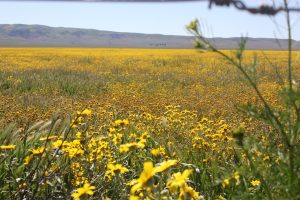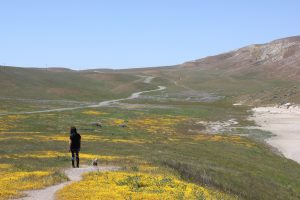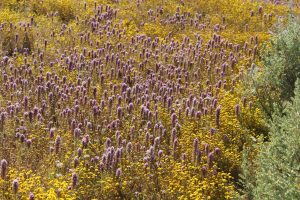super bloom and history

Carmela, Henry, and I went traveling last month to see the famous Southern California super bloom and experience a little history.
The super bloom doesn’t happen every year, only when the state has experienced a lot of rain. And when that happens, the hillsides and valleys erupt with a full display of botanic beauty.
We’ve seen super blooms before, but to see this year’s super bloom, we got in our car and drove 231 miles to the Carrizo Plain National Monument, a 250,000-acre preserve in the southeast corner of San Luis Obispo County near the Kern County line. There were spectacular flora displays closer to home, but my sweetheart and I weren’t just looking for flowers, we were also on an historical quest.
The Carrizo Plain, according to Dr. Paula M Schiffman, is one of two places in the state that comes closest to what the Los Angeles basin was like when Cabrillo arrived in California in 1542. Dr. Schiffman is a terrestrial ecologist at California State University Northridge, “who uses quantitative and experimental approaches to address questions about plants and their ecologies.”
Carmela and I first came across Dr. Schiffman’s work when we were researching background for Port Town, a history book we wrote about the Port of Long Beach. The coastal plain of Southern California exists on a somewhat narrow prairie between the mountains and the ocean. In earlier days, the flatlands were covered in wildflowers, grasses, and other short plants. Oak, sycamore, willow, and alder trees lined the creeks and rivers that ran to the sea.

Ground squirrels, rabbits and gophers who lived in burrows beneath the ground were so numerous that it was dangerous to ride a horse across an open field at a pace faster than a walk. Numerous grizzly bears, which prefer open areas to woodlands, roamed the area, using their long claws to dig up the ground in search of the “rodents, roots, bulbs, fungi, and insect grubs,” according to Dr. Schiffman.
The bears and the burrowing smaller animals aerated the soil and helped prepare it for the next bloom. California then, as now, was a land of drought and flood. Winter rains would stimulate the seeds to grow into plants, flower, produce new seeds and die, all within a few weeks or months. During years of drought, the seeds were able to remain dormant for years, until the next rainy year came along.
When the Spanish arrived in great numbers, the ecology of the coastal plain quickly changed. After the mission settlements were established, the surrounding property was converted to agricultural uses. Cattle, sheep, horses, and farming quickly replaced the wild environment that had existed in the past. Plant species from the Mediterranean area were carried to the new world either by plan or by accidental introduction of seeds stuck among the arriving cargo and people. The cattle would eat the plants and spread the seeds in their dung.

The changes in the Southern California environment were gradual enough that the new European residents paid little attention. But slowly the natural wild landscape began to change to an agricultural environment.
Today the grizzly bears are gone from California – the last ones killed off in the early 20th century – but the vacant spot they left in the environment continues.
There are no grizzlies in the Carrizo Plain, but there are pronghorn antelope, gophers, kangaroo rats, and numerous birds and insects, plus 200 native plants – more than 60 percent of which were found in the original Southern California coastal plain.
The road we drove on that spring day was rough, unpaved for miles in some places with a great rocky and gavel washboard surface. But the weather was fantastic and the view unsurpassed. Carmela and I were spellbound by the natural beauty of the place.
Henry followed Carmela down the trails and across the fields like a faithful little boy, pausing only to sniff the bushes and pee on the rocks.
We all had a grand and glorious time.
Do you have a dissenting opinion or any opinion at all on the subject? Contact me at george@georgeleecunningham.com and let me know. Meanwhile, you can always subscribe and get an email reminder of blog postings. Your name will not be shared and you may cancel at any time.
Dr. Schiffman’s account of the Los Angeles coastal prairie can be found in the “Land of Sunshine: an Environmental History of Metropolitan Los Angeles.”
